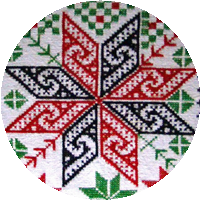Mesoamerican Jade Art
Please click any thumbnail at right for a larger image!
Click any highlighted name to hear its pronunciation!
Jade was one of the precious stones that defined Mesoamerican art and culture from almost their beginnings. The Olmecs of the southern Gulf Coast were among the first to use it in art and architecture, with sculptures and jewelry appearing as early at 1000 BC! The Olmecs used jade for decorative and ritual purposes, and they designed many spiritual and mythical themes into the material. This miniature sculpture depicts a weeping infant with plump contours. Infants were very common in Olmec art as they likely alluded to spiritual beliefs in the rejuvenation of kings and crops.
National Museum of Anthropology and History
As seen with the infant above, the promise of new life was a recurrent theme in Olmec art. This hefty piece of jade was carved and smoothed into a long celt with tapering ends, a style known from especially the Olmec civilization. Many of these celts were further decorated with solid etchings. Some anthropologists (myself included) believe that these etched images could represent early forms of writing: abstract, precise symbols derived from familiar images.
The main figure is the left-facing profile of a supernatural being with animal elements around the eye and mouth. The most interesting part of this carving, however, is the sprout at the top of the image, perhaps a reference to a maize stalk or a sacred tree. It rises from the "cleft" atop the headpiece, which could symbolize the earth's surface.
Metropolitan Museum of Art
Known as the world's "toughest" stone, jade is a notoriously difficult material to master, let alone carve. I give proper credit and respect to the ancient craftsmen who persevered with accuracy and patience to work with this hard mineral. It is even more remarkable to see jade carved from individual pieces and then assembled into works of unique beauty such as this funeral mask from the Zapotec site of Monte Albán, Oaxaca. Crafted from 25 pieces of jade, this mask represents a spirit animal. The old consensus was that this represented a bat, but more recent research suggests that it's the leering visage of a jaguar. Many Mesoamerican peoples regarded bats and jaguars as powerful creatures in the worlds of nighttime and spirits.
National Museum of Anthropology and History
We know from notably the Aztecs that jade was more valuable than even gold and silver! Its deep green hues recalled the mythic World Tree that linked the earth to the spirit worlds above and below, as well as droplets of water, one of the first sources of life. By extension, it was believed to have healing powers.
Trinkets of jade were often bartered for other goods, and that may have been the purpose of these small carvings. The fine detail hints at the carver's attention; the human faces are adorned with earrings, headdresses and emblems.
National Museum of Anthropology and History
The Maya prepared funeral masks and precious jewelry for their deceased kings and queens, and archaeologists have discovered rich troves of jade and other valuable artifacts in Maya royal burials. The Temple of the Inscriptions at Palenque was built to not only house the tomb of the city's most famous king, K'inich Janaab'-Pakal, but also inscribe the divine king's place in mythical time. Pakal ruled Palenque for most of the seventh century AD, and his reign saw important advances in political diplomacy and monumental architecture. Linda Schele and Peter Mathews detailed the complex symbolism around the king's sarcophagus, the largest and most artistic in all Mesoamerica, as it narrates the king's descent into the underworld and the encounters with spiritual ancestors. The sarcophagus contained a wealth of jade jewelry and a mosaic mask upon the deceased Pakal, featured in replica in this display.
National Museum of Anthropology and History
Some of Mesoamerica's greatest works in jade come from the Petén lowlands between southeast Mexico and northern Guatemala. Maya sculptors worked with minute jade beads and set them with quartz, shell, and other precious materials to produce ornate miniatures such as this mask from Tikal, Guatemala.
National Museum of Archaeology and Ethnology
We cannot talk about Maya jade in Guatemala without this note: Guatemala was the only source of jade in Mesoamerica, and its scarcity gave it all the more value. (For the rest of the Americas, only parts of the United States have other natural jade sources.) Because it was such a material of value and standard for wealth for many Mesoamerican elite groups, for centuries kingdoms and empires strove to control its circulation.
The K'ichee' of Guatemala's southwestern highlands had one of the biggest Maya empires by the Postclassic Period. However, these examples of jade jewelry from the Nebaj of western Guatemala date to the Classic Period, indicating that they were already quite formidable by then. The earflares at left are carved into elegant blossoms; they were made during the Early Classic Period, from 250 to 600 AD. The necklace at right dates to the Late Classic (600-900).
National Museum of Archaeology and Ethnology













